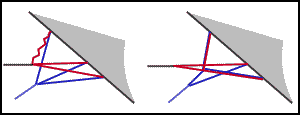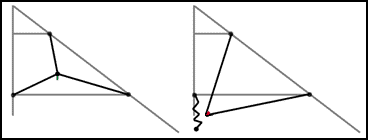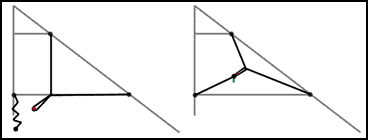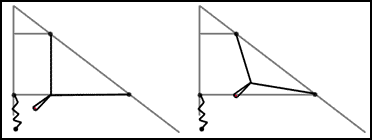Dynamic Bridle
The term "dynamic bridle" generally describes any kind of bridle that includes some component which is designed to move under tension in normal use. This page describes the simplest and most common form of a dynamic bridle and shows how it differs from a traditional 3 leg static bridle. It discusses some of the benefits of a dynamic bridle in terms of improved handling characteristics of the kite, and shows a simple process for converting an existing static bridle into a dynamic one.
The bridle on a kite is comprised of several lengths of bridle line (that's kiting terminology for a special kind of string) which are attached permanently to the frame of the kite. These come together to form a single point, the "Tow Point", to which the flying lines are attached.
The bridle is the critical link between you and the kite. It determines how the input that you provide in terms of pulling or pushing on the control lines is transferred to the kite. It also affect how changes in the position of the kite are fed back to you in terms of line pressure and the general responsive feel of the kite.
On a static bridle, the Tow Point is fixed in one position when the bridle is pulled taught. On a dynamic or active bridle, the Tow Point has some degree of movement which is designed to improve the handling of the kite in certain conditions. For example, to make it turn tighter, track better in a straight line, perform more radicals tricks, or some combination of the above.
A static bridle is one which is designed to remain fixed in a particular position while under tension. The diagram below depicts a static bridle in the left frame, shown here as a front-on view of the right wing of a kite. The 3 legs of the bridle are known as the inhaul (the line on the left going from the T-Piece to the tow point), the upper outhaul (going from the upper leading edge connector to the tow point) and the lower outhaul (going from the lower leading edge connector to the tow point). On most kites, the two outhauls, or one of the outhauls and the inhaul, are actually a single piece of line to which the third leg is attached. The tow-point, shown here as a green flash, is the point to which the flying lines are attached. On a static bridle, the tow point is designed to remain in a fixed position while the bridle is under tension.

|
|
Diagram 1 Static vs Dynamic Bridle |
The dynamic bridle, shown in the middle frame has an extra section, the yoke, that connects the tow point to the outhauls. The lengths of the inhaul and outhauls may not necessarily be the same as on the static bridle, but it is possible to construct a dynamic bridle that has the tow-point in the same relative position as the static bridle equivalent.
The key feature of the dynamic bridle is shown in the right frame. Depending on the pressure applied to one or both flying lines, the tow point automatically shifts up or down whilst still maintaining tension on all lines in the bridle. On an equivalent static bridle, one leg or more will go slack if the tow point moves from its "home" position.

|
|
Diagram 2 Side View of Dynamic Bridle |
The diagram above shows this in action from a side-on view. The blue lines represent the "normal" bridle position. When the kite is tilted forward, the upper outhaul on the static bridle becomes slack (left) whereas the dynamic yoke automatically shifts to a higher position, keeping all bridle lines tight (right).
The beneficial effects of the Dynamic Bridle are in improving the tracking, turning and trickability of the kite.
In general, a higher tow-point (i.e. set closer the nose) will increase the forward speed of a kite and reduce the turning speed. Conversely, a lower tow point will slow down the forward speed but radically increase the turning ability of the kite. Too much of either is a bad thing, introducing sluggishness, unresponsivness or perhaps excessive oversteer. Designing a static bridle is about finding the right balance of these characteristics and making trade-offs between them.
The dynamic bridle can provide the best of both worlds. When flying in a straight line there is equal (or near equal) pressure on both flying lines. The effect on the bridle is that the tow points are pulled in and up, increasing the drive and improving the tracking. When one line (say the right) is pulled to instigate a turn, the opposite wing (the left) falls back away from the pilot. The dynamic bridle on the tensioned side (right) shifts the tow point down and out towards the tips, producing a tight spin. As soon as the lines are pulled back to equal pressure, the bridle reverts back to its upper position and prevents the oversteer that would normally be found on a low set bridle.
Many cutting edge freestyle tricks rely on getting in and out of positions where the kite is no longer facing the flier. Axels and Flat Spins, for example, have the face of the kite pointing more or less down towards the ground. In these positions, a static bridle would normally have one or more legs loose. When the flier tries to bring the kite out of the move or directly into another, the first few valuable moments when a line is pulled or popped are spent on taking up the slack in the bridle.
A dynamic bridle has a wide range of positions where all the bridle lines are tight, allowing the flier's actions to be transfered directly to the frame of the kite. A static bridle will often have one or two legs slack, forcing all the line pressure to be transmitted through a single bridle point resulting in instability and unpredictable control.
The most striking example of this benefit of the dynamic bridle is when trying to do Multiple Axels and Flat Spins. With a static bridle, the timing and force of each consequetive "pop" is critical to get the kite to remain flat but continuing to rotate. A dynamic bridle gives a much larger margin of error, to the extent that it is possible to keep Multiple Axels and Flat Spins going almost continuously, or at least until your flying lines start binding (which happens at about 25 revolutions, I can reliably inform you).
If your kite has a 3 leg static bridle in which the upper and lower outhauls are comprised of a single length of bridle line to which the separate inhaul line is attached, then you might want to try converting the original static bridle to a dynamic bridle. The beauty of this approach is that you use the original bridle and convert it using just one simple knot on each side. The process takes less than a minute, and if you don't like it, you can simply untie the knot to revert to the original bridle.
This guide was originally written with respect to the range of trick kites released by Benson Kites in 1995, the Box of Tricks, Reflex and Fusion. However, many kite manufacturers use a similar approach so the technique will be applicable to various other kites as well. Also know that many kite manufacturers, including Benson Kites, now use dynamic and Active Bridles on their kites as standard, so you might not need to do anything at all.
The diagram below shows a static bridle show on the left, which consists of a single piece of line connecting the upper and lower leading edge points. This is then attached to the inhaul at the tow point (shown as a green flash) with a lark's head knot. Slip this outer line off the tow point and, keeping the line folded at the original bridle mark (red dot), pull the line down towards the tail.

|
|
Diagram 3 Static Bridle |
Fold the line in half at the original bridle mark and tie an overhand knot with the loop, tying the upper and lower sections together to make the yoke. The outer line, now containing the loop section, can now be re-attached to the tow point using a lark's head. The line is attached at the original bridle point. This is shown in the diagram below.

|
|
Diagram 4 Dynamic Bridle |
The exact position of the knot can be changed to get different effects. The optimum position for the Box of Tricks and Fusion has the knot directly in line with the lower spread (as shown below, left) when the bridle is pulled taut down against the frame. The Reflex requires a slightly higher knot as show on the right.

|
|
Diagram 5 Typical Position for Box of Tricks (left) and Reflex (right) |
Moving the knot up increases the length of the yoke and causes a more dramatic dynamic effect. An excessively dynamic bridle is characterised by the nose of the kite "rocking" forwards, particularly when coming out of tight turns. The knot can be moved further down towards the tow point to shorten the yoke and limit the dynamic effect.